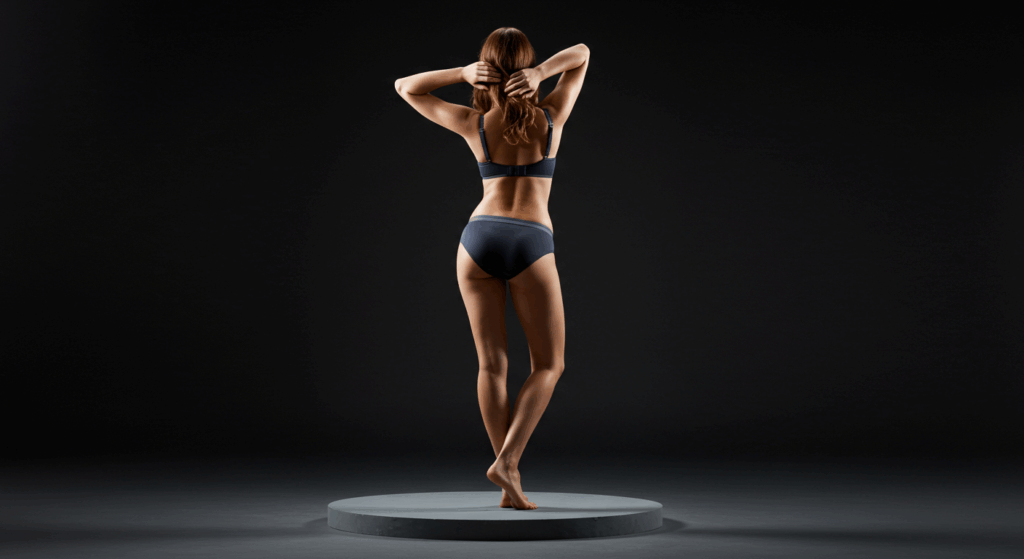For many transgender women (MTF), achieving a feminine body contour, particularly the coveted hourglass figure, is a significant aspect of their gender affirmation journey. While hormone replacement therapy (HRT) induces considerable changes in fat redistribution and body shape over time, surgical interventions can play a crucial role in more rapidly and precisely sculpting the body to align with one’s internal sense of self. This comprehensive guide, written from a surgeon’s perspective, delves into the various body feminization surgeries available to create an hourglass silhouette, explaining the procedures, anatomical considerations, and expected outcomes in detail.

Table of Contents
Understanding the Hourglass Figure: Anatomical Basis and Feminine Aesthetics
The classic hourglass figure is characterized by a narrower waist circumference compared to the measurements of the hips and bust. This differential in proportions creates a visually distinct and often desired feminine silhouette. Anatomically, this shape is influenced by the underlying skeletal structure (particularly the width of the rib cage and hips), the distribution of subcutaneous adipose tissue (fat beneath the skin), and the development of musculature. In individuals assigned male at birth, the rib cage tends to be wider and less tapered, the hips narrower, and fat distribution patterns are typically more abdominal. HRT can shift fat distribution towards the hips and breasts, but its effects on skeletal structure are minimal in adults.
The Role of Surgery in Sculpting an Hourglass Silhouette
Body feminization surgery aims to enhance the development of feminine curves and proportions, often by addressing the distribution of adipose tissue and, in some cases, the underlying skeletal structure indirectly through soft tissue manipulation. The procedures discussed in this guide focus on creating the visual impression of a wider bust and hips relative to a narrower waist.

Surgical Procedures for Achieving an Hourglass Figure
Several surgical techniques can be employed, often in combination, to sculpt the body into a more feminine hourglass shape.
Breast Augmentation: Enhancing the Upper Curve
Increasing breast volume is a fundamental aspect of feminizing the upper torso and contributing to the hourglass silhouette.
- Implant-Based Augmentation: This involves the surgical placement of silicone or saline-filled implants beneath the breast tissue or pectoral muscle.
- Implant Material: Silicone implants are filled with a cohesive gel and are available in various shapes (round, teardrop), sizes, and profiles (projection). Saline implants are filled with sterile saltwater and are typically less firm than silicone.
- Implant Placement: Implants can be placed subglandularly (beneath the breast tissue), subpectorally (beneath the pectoralis major muscle), or in a dual-plane position (partially beneath the muscle). The optimal placement depends on the individual’s anatomy and desired outcome.
- Incision Sites: Common incision sites include the inframammary fold (underneath the breast), periareolar (around the nipple), axillary (in the armpit), and transaxillary (through the armpit). Each has its advantages and disadvantages regarding scarring and implant placement.
- Fat Grafting to the Breasts (Autologous Breast Augmentation): This technique involves liposuction to harvest fat from other areas of the body (e.g., abdomen, thighs), processing the fat, and then injecting it into the breasts to increase volume and improve shape.
- Advantages: Uses the patient’s own tissue, resulting in a more natural feel and appearance. Can also provide contouring to the donor areas.
- Limitations: The amount of volume increase achievable is typically less than with implants, and some of the transferred fat may be reabsorbed by the body over time. Multiple procedures may be needed to achieve the desired size.
Waist Cinching Procedures: Creating a Narrower Midsection
Surgical options to directly narrow the waist are limited and often involve complex procedures with significant risks. However, procedures focusing on the surrounding areas can create the illusion of a smaller waist.
- Liposuction of the Flanks and Abdomen: This is a common procedure to remove excess subcutaneous fat from the sides of the torso (flanks or “love handles”) and the abdomen. By reducing the bulk in these areas, the waistline can appear more defined and narrower relative to the bust and hips.
- Techniques: Various liposuction techniques exist, including tumescent liposuction (using a fluid injection to facilitate fat removal), ultrasound-assisted liposuction (UAL), and power-assisted liposuction (PAL). The choice of technique depends on the surgeon’s preference and the individual’s needs.
- Extent of Liposuction: The amount of fat that can be safely removed is limited. The goal is to contour the area to create a more defined waistline, not to remove massive amounts of fat.
- Circumferential Liposuction (360 Liposuction): This involves liposuction of the entire circumference of the torso, addressing the abdomen, flanks, and back to create a more sculpted and streamlined midsection.
- Waist Training Surgery (Rib Resection/Modification): This is a highly controversial and rarely performed procedure involving the surgical removal or modification of the lower floating ribs to achieve a permanent reduction in waist circumference.
- Risks and Ethical Considerations: This procedure carries significant risks, including damage to internal organs, chronic pain, and respiratory complications. It is generally not recommended by most reputable surgeons due to the high risk-to-benefit ratio and ethical concerns regarding irreversible skeletal alteration for purely cosmetic purposes.
- Focus on Soft Tissue Contouring: Modern surgical approaches for waist definition primarily focus on liposuction of the surrounding soft tissues to create the visual effect of a narrower waist without directly manipulating the bony structures of the rib cage.
Hip Augmentation: Enhancing the Lower Curve
Creating wider hips is crucial for achieving the lower curve of the hourglass figure.
- Fat Grafting to the Hips and Buttocks (Brazilian Butt Lift – BBL, Modified for Hip Emphasis): Similar to fat grafting to the breasts, this involves liposuction to harvest fat from donor areas and injecting it into the hips and buttocks to increase volume and create a more curvaceous silhouette. In the context of body feminization for an hourglass figure, the focus is often on lateral hip augmentation to widen the hips and enhance the waist-to-hip ratio.
- Injection Technique: The fat is injected into multiple planes within the subcutaneous and intramuscular tissues to maximize survival and create a smooth, natural contour.
- Volume Considerations: The amount of fat that can be grafted to the hips varies depending on the donor site availability and the individual’s anatomy and desired outcome.
- Silicone Hip Implants: Solid silicone implants can be surgically placed into pockets created within the subcutaneous or intramuscular planes of the hips to increase their width and projection.
- Implant Material and Shape: Hip implants are specifically designed for the buttock and hip region and come in various shapes and sizes to achieve the desired contour.
- Incision Sites: Incisions are typically placed in discreet locations, such as the gluteal crease (the fold between the buttocks and the thighs).
- Considerations: While effective for increasing hip width, implants may carry risks such as capsular contracture (scar tissue tightening around the implant), infection, and implant displacement. Fat grafting is often preferred for its more natural feel and lower risk of these complications.
The Surgical Process: From Consultation to Recovery for Body Feminization
Undergoing body feminization surgery to achieve an hourglass figure involves a similar multi-stage process as other surgical procedures.
Initial Consultation and Assessment
A thorough consultation with a board-certified plastic surgeon experienced in body feminization is essential. The surgeon will:
- Review your medical history: To identify any contraindications or risk factors.
- Understand your goals and expectations: To determine your desired body shape and discuss the feasibility of achieving it through surgery.
- Perform a physical examination: Assessing your current body proportions, fat distribution, and skin elasticity.
- Discuss the available surgical options: Explaining the different procedures, their risks, benefits, and limitations.
- Develop a personalized surgical plan: Tailored to your individual anatomy and aesthetic goals, which may involve a combination of procedures.
- Provide information about the anesthesia, surgical facility, and cost.

Pre-Operative Preparation
Following the consultation, you will receive detailed pre-operative instructions, which may include:
- Optimizing your health: This may involve quitting smoking, managing any underlying medical conditions, and maintaining a stable weight.
- Avoiding certain medications: Such as blood thinners and non-steroidal anti-inflammatory drugs (NSAIDs) for a specified period before surgery.
- Undergoing pre-operative medical tests: To ensure you are fit for surgery.
- Arranging for transportation and post-operative care.
The Surgical Procedures
Body feminization surgeries are typically performed under general anesthesia. The specific techniques and the duration of the surgery will depend on the combination of procedures being performed.
- Liposuction: Small incisions are made in the targeted areas, and a cannula (a thin tube) is inserted to suction out excess fat.
- Fat Grafting: Harvested fat is processed and then injected into the breasts, hips, or buttocks through small incisions.
- Implant Placement: Incisions are made according to the chosen approach, pockets are created for the implants, and the implants are inserted and positioned. Incisions are then closed with sutures.
Post-Operative Recovery
The recovery period after body feminization surgery varies depending on the procedures performed and the individual’s healing process.
- Immediate Post-Op: Expect swelling, bruising, and discomfort in the treated areas. Pain medication will be prescribed. Compression garments are typically required to help reduce swelling and support the tissues.
- First Few Weeks: Swelling and bruising will gradually subside. Activity will be limited, and you will need to follow specific instructions regarding wound care, showering, and garment use.
- Mid-Term Recovery (Weeks to Months): You can gradually resume normal activities as healing progresses. The final results of the surgery will become more apparent as the swelling fully resolves.
- Long-Term Recovery (Months to a Year): The tissues will continue to settle, and any scars will gradually fade. It’s important to maintain a stable weight to preserve the surgical results.
Potential Risks and Complications of Body Feminization Surgery
As with any surgical procedure, body feminization surgeries carry potential risks and complications, including:
- Infection: Although rare with proper surgical technique and post-operative care.
- Bleeding and Hematoma: Collection of blood under the skin requiring drainage.
- Seroma: Collection of fluid under the skin, which may need to be drained.
- Poor Wound Healing or Scarring: Scars are inevitable but typically fade over time.
- Changes in Sensation: Numbness or altered sensation in the treated areas can occur and may be temporary or permanent.
- Asymmetry: Despite meticulous planning, some degree of asymmetry can occur.
- Fat Grafting Complications: These can include fat necrosis (death of fat cells), cyst formation, and oil cysts.
- Implant-Related Complications: These can include capsular contracture, implant rupture or leakage, infection, and implant displacement.
- Deep Vein Thrombosis (DVT) and Pulmonary Embolism (PE): Rare but serious risks associated with any major surgery.
- Anesthesia-Related Complications: Rare but possible adverse reactions to anesthesia.
- Unsatisfactory Aesthetic Outcome: The final result may not fully meet the patient’s expectations, potentially requiring revision surgery.
It is crucial to discuss these risks thoroughly with your surgeon before proceeding with surgery.
Expected Outcomes and the Journey to an Hourglass Figure
Body feminization surgery can significantly contribute to achieving a more feminine hourglass figure by enhancing the bust and hips relative to the waist. The specific outcomes will depend on the individual’s anatomy, the procedures performed, and their desired aesthetic goals.
- Enhanced Breast Volume and Shape: Breast augmentation can create a fuller and more feminine upper torso.
- More Defined Waistline: Liposuction of the flanks and abdomen can sculpt a narrower midsection.
- Increased Hip Width and Projection: Fat grafting or implants can create more curvaceous hips.
- Improved Overall Body Proportions: The combination of these procedures can lead to a more balanced and feminine hourglass silhouette.
It’s important to have realistic expectations and understand that achieving the ideal hourglass figure is a journey that may involve multiple procedures and a commitment to maintaining a healthy lifestyle.
Combining Body Feminization with Other Gender Affirming Procedures
Body feminization surgery is often performed in conjunction with other gender affirming procedures, such as facial feminization surgery (FFS) and voice feminization surgery, to achieve a more comprehensive and congruent physical presentation. The timing and combination of these procedures are individualized based on the patient’s priorities and overall transition plan.

Conclusion: Sculpting the Feminine Form
Body feminization surgery offers powerful tools for transgender women seeking to achieve a more feminine hourglass figure. Through procedures like breast augmentation, liposuction of the waist, and hip augmentation with fat grafting or implants, surgeons can help sculpt the body to align more closely with the individual’s gender identity and aesthetic goals.
While these procedures involve careful planning, surgical expertise, and a period of recovery, the transformative impact they can have on a person’s self-confidence and well-being is significant. Choosing a qualified and experienced plastic surgeon who specializes in body feminization is paramount to ensure a safe and successful journey towards a more affirmed and congruent physical self. This comprehensive approach to body contouring, tailored to the individual’s unique anatomy and desires, represents a vital step in the broader process of gender transition and self-discovery.
Visit Dr.MFO Instagram profile to see real patient transformations! Get a glimpse of the incredible results achieved through facial feminization surgery and other procedures. The profile showcases before-and-after photos that highlight Dr. MFO’s expertise and artistic vision in creating natural-looking, beautiful outcomes.
Ready to take the next step in your journey? Schedule a free consultation with Dr. MFO ( Best Facial Feminization Surgeon for You) today. During the consultation, you can discuss your goals, ask any questions you may have, and learn more about how Dr. MFO can help you achieve your desired look. Don’t hesitate to take advantage of this free opportunity to explore your options and see if Dr. MFO is the right fit for you.









